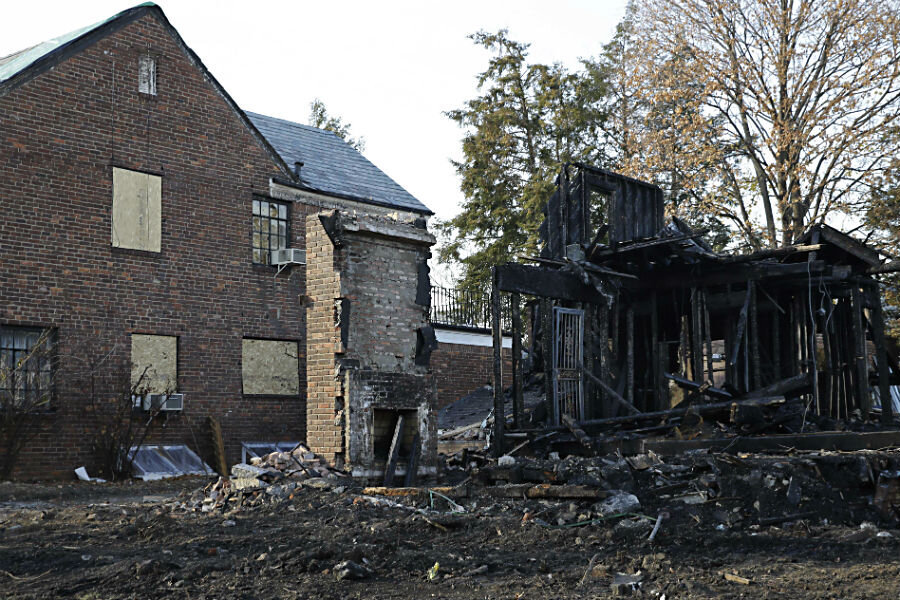Mysterious arsonist in NYC Jewish neighborhood: Anti-Semitic attacks?
Loading...
| New York
Somebody has been burning down new homes in a New York City neighborhood populated by Bukharian Jews, and police aren't sure whether the victims are being targeted for their religion, their architectural taste, or for no reason at all.
Over the past six weeks, an arsonist has torched six buildings in the same tight-knit section of the Forest Hills neighborhood in eastern Queens, police say. Four of the fires hit homes that were still under construction, including one house that was burned twice.
The arsonist's motive is still a mystery. One theory is that he is targeting opulent, oversized homes that have been replacing the neighborhood's modest dwellings. Another holds that the person behind the fires is just disturbed.
At one fire scene, someone left behind an encrypted note apparently intended to throw off investigators.
Police say they don't have evidence suggesting that the arsons are hate crimes, but the fact that most of the victims have been Bukharian Jews, a group that fled persecution in Central Asia, has the neighborhood on edge.
"I don't know what to think," said Rabbi Zalman Zvulonov, whose future home, still under construction, was torched early Monday morning — the second time it was targeted in three weeks. "There are only Jewish houses burning so that tells you something. But I couldn't point a finger. I don't know."
Police held a meeting Tuesday at a local Jewish community center to solicit information and calm fears.
"The motives are — I wish we knew," New York Police Department Commissioner William Bratton told reporters Monday. "At this time we do not think it is a terrorist act or a hate crime."
No one has so far been injured in the fires. In addition to the six that were heavily burned, seven others nearby sustained damage from spreading flames.
Bukharian Jews immigrated to New York in the 1980s from Uzbekistan, Tajikistan and throughout Central Asia.
Many have done well. Behind fortress-like fences, luxury cars are parked in the driveways of rebuilt multistory homes that replaced smaller Tudor-style homes.
The community has raised $50,000 in award money for information leading to an arrest, and city officials have offered an additional $12,000.
"It could be just a crazy fanatic ... but nothing happens for no reason," said John Yakuboy, a general contractor and Bukharian Jew who emigrated from Uzbekistan in 1980. He spoke as he installed lights atop the roof and along the fence of a home he's building one block from an arson site.
Surveillance footage from a neighbor's home shows a man wearing a hooded sweatshirt walking through the ashes of a torched house on Nov. 25. Investigators discovered a strange note atop a nearby car. It contained six rows of five letters and 18 rows of two numbers, along with the following instruction: "Decode this message to find the person who caused the fire."
A detective and FBI agent both decrypted the puzzle and came up with the name of a store owner, whom police questioned and ruled out as a suspect. A second person captured on security video at one of the fires has similarly been ruled out.
Robert Boyce, the NYPD's chief of detectives, said investigators have some physical evidence but "nothing that would lead us to a single person."
Boyce said fire marshals and investigators from the department's arson and explosion squad, as well as the major case unit, believe the suspect likely lives nearby. But unlike other pattern arsonists, this one uses only materials found at the scene, not accelerants, he said.
Ruben Boruhkov, who came to New York in 1980 from Tajikistan and whose sister lives next door to a house that burned on Nov. 25, said the culprit must have a motive.
"He's doing revenge for sure," he said. "What kind of revenge? I don't know."
Many in the community say the arsons appear to be an escalation of the longstanding criticism of their building projects.
“Our people, they’re hardworking, hard-building,” Rafael Nektalov, the editor of The Bukharian Times, a Russian-language weekly newspaper, said in an interview. “We want to have a beautiful life in beautiful buildings.”
Bukharians — mostly from Kazakhstan, Kyrgyzstan, Tajikistan, Turkmenistan and Uzbekistan — began settling in New York City in large numbers after the collapse of the Soviet Union. Community leaders say the population now numbers about 50,000, with most living in Queens.







